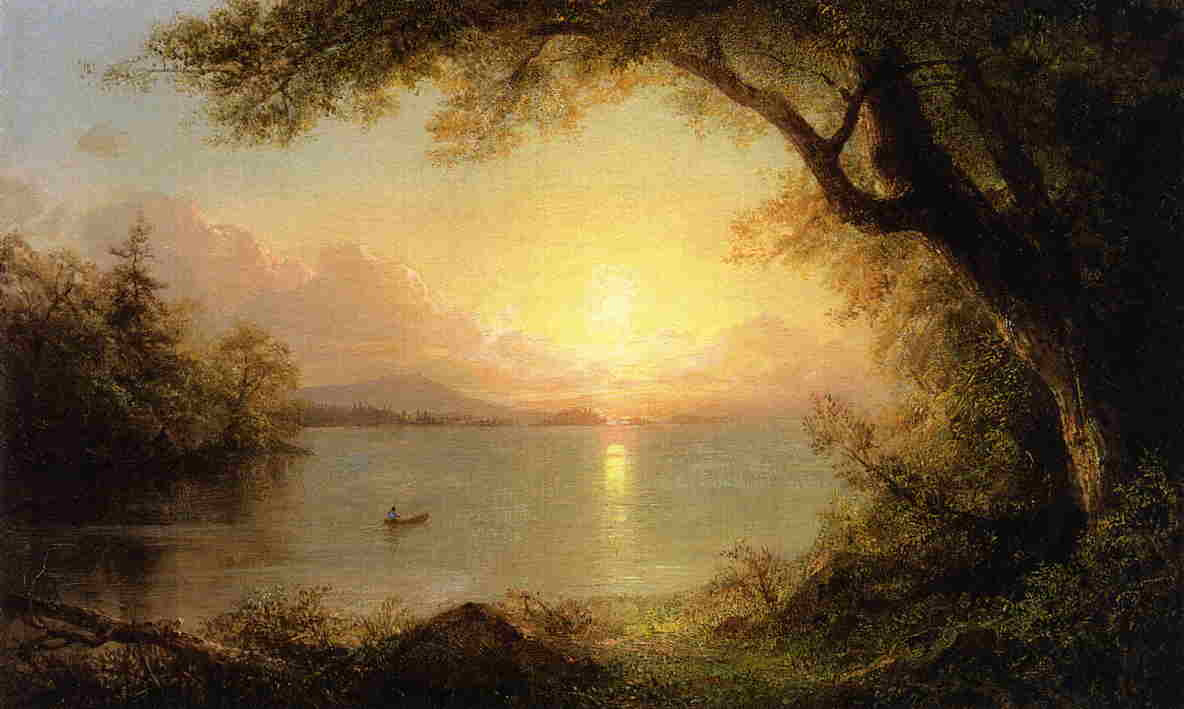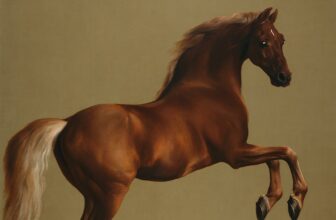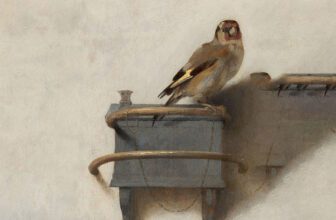
Meaning of Landscape in the Adirondacks Painting by Frederic Edwin Church
A Masterpiece of American Luminism
“Landscape in the Adirondacks” by Frederic Edwin Church is more than just a visually stunning painting; it is a rich visual document steeped in the ideologies, artistic movements, and national sentiments of 19th-century America. Completed in 1870, the painting exemplifies the grand, almost spiritual approach that the Hudson River School artists brought to the American wilderness. Church, one of the most distinguished figures in this movement, captured the untamed beauty of the Adirondack Mountains with masterful detail, light, and composition. This work, currently held by the Smithsonian American Art Museum, is emblematic of a broader cultural and philosophical narrative that stretches beyond aesthetics and into the American identity itself.
Who Was Frederic Edwin Church?
To understand the painting, one must understand the painter. Frederic Edwin Church (1826–1900) was a central figure in the Hudson River School, a group of American landscape painters who flourished in the mid-19th century. Church studied under Thomas Cole, the school’s founder, and quickly rose to prominence through his vast, luminous, and meticulously rendered landscapes. His works often depicted the American wilderness as a new Eden, a place of divine grandeur and national promise.
Church was also influenced by science, theology, and Romantic literature, all of which found expression in his paintings. He traveled widely, to South America, the Arctic, and the Middle East, in search of sublime and exotic landscapes, but he never lost touch with the American terrain. The Adirondacks in New York State, with their rugged mountains, deep forests, and crystal-clear lakes, became one of his most cherished subjects.
The Adirondacks and American Nationalism
The painting “Landscape in the Adirondacks” was created in 1870, a time when America was healing from the Civil War and in the midst of westward expansion. Nature was not merely a backdrop in this era, it was a symbol of national renewal and potential. The Adirondack region, located in northeastern New York State, was seen as a therapeutic wilderness, a sanctuary from the industrialized world and the scars of war.
Artists and thinkers of the time embraced the wilderness as a uniquely American subject. Church, a master of romantic landscapes, turned his gaze to the Adirondacks not only for their aesthetic appeal but also for their metaphorical weight. The mountains and lakes represented strength, purity, and a return to Edenic simplicity, key themes in the American cultural imagination.
Description and Analysis: What Is Happening in the Painting?
At first glance, “Landscape in the Adirondacks” seems like a serene, almost photographic portrayal of a wilderness scene. But Church’s careful construction and symbolic layering elevate the painting far beyond a simple depiction of nature.
Visual Elements:
Foreground: In the foreground, Church includes detailed renderings of trees, rocks, and a small body of water, perhaps a calm inlet or river. The texture of the bark, the shimmering reflection in the water, and the foliage are rendered with an almost scientific precision.
Middle Ground: A boat with two figures, presumably travelers or fishermen, rests on the water, dwarfed by the grandeur of the surrounding landscape. Their inclusion adds a human element to the otherwise untouched wilderness, suggesting a harmonious coexistence between man and nature.
Background: Towering mountains dominate the background, their peaks illuminated by sunlight breaking through a cloudy sky. This interplay of light and shadow creates a dynamic, almost spiritual quality. The use of luminism, a hallmark of Church’s style, imbues the scene with a transcendent glow.
Light and Atmosphere:
Church was renowned for his use of light, and “Landscape in the Adirondacks” is a masterclass in luminism. The scene is suffused with a golden, almost sacred light that filters through the clouds and dances on the water’s surface. This illumination suggests divine presence and order, a common theme in Hudson River School works.
Symbolism and Meaning: A Spiritual Vision of Nature
Church’s painting is deeply symbolic, reflecting themes of divine providence, national destiny, and personal introspection.
1. Nature as Divine Creation:
Church, like his mentor Thomas Cole, believed that nature was a reflection of God’s handiwork. The untouched Adirondack wilderness, rendered with reverence and care, becomes a cathedral of sorts, a place for spiritual renewal and divine encounter.
2. Man in Harmony with Nature:
The small figures in the boat are not intrusive but rather integrated into the natural setting. They represent a Romantic ideal: humanity as a humble participant in the larger natural order. This idea stood in stark contrast to the industrial revolution, which was seen by many artists as alienating and destructive.
3. Light as Symbol of Revelation:
The glowing light in the painting may symbolize revelation, clarity, or hope. Emerging from the clouded sky, the light bathes the mountains in warmth and hints at transcendence. It’s a visual metaphor for understanding, spiritual awakening, or even post-war redemption for a divided nation.
4. The Adirondacks as American Eden:
In the aftermath of the Civil War, America yearned for peace, unity, and a return to idealism. The Adirondacks, untouched and majestic, offered a symbol of that possibility. Church’s rendering of the region as both awe-inspiring and accessible spoke to the collective desire for healing and wholeness.
Artistic Style and Technique: Hudson River School and Luminism
“Landscape in the Adirondacks” is a quintessential example of the Hudson River School, a uniquely American art movement that flourished from about 1825 to 1875. Key characteristics of this style include:
Panoramic Views: Expansive compositions that draw the viewer into a vast, immersive world.
Detailed Realism: Intricate brushwork that captures even the smallest details of flora, rocks, and water.
Dramatic Light and Weather: Use of changing light and atmospheric effects to convey mood and meaning.
Moral and Philosophical Themes: Nature as a vehicle for exploring divine, national, and personal questions.
Within the Hudson River School, Church was particularly associated with luminism, a style characterized by calm, reflective water, diffused light, and a sense of spiritual stillness. His training in topographical accuracy also made his works scientifically credible as well as emotionally stirring.
Creation of the Painting: How It Was Made
Church was a meticulous planner. Before completing “Landscape in the Adirondacks,” he would have conducted extensive field studies. These included pencil sketches, oil studies on site, and written observations about the light, atmosphere, and geography of the location.
He often used a camera obscura to help with accurate topography, and he took copious notes on the changing weather conditions. His studio in Olana, the Moorish-style home he built overlooking the Hudson River, was a sanctuary where he could bring these elements together into a unified vision.
Although we cannot pinpoint the exact site of the painting, Church’s process suggests that the scene is likely an idealized composite rather than a direct replication of one location. He merged different visual elements from the region into a harmonious whole, a curated reality that served artistic and symbolic ends.
Current Location: Where Is the Painting Today?
“Landscape in the Adirondacks” is currently housed in the Smithsonian American Art Museum in Washington, D.C. As part of the museum’s extensive collection of American art, the painting continues to attract attention for its beauty and historical significance. It is often displayed alongside other Hudson River School works and serves as a touchstone for discussions about American art, nature, and identity.
The museum setting allows modern viewers to engage with the painting not just as an artifact of the past, but as a living piece of cultural heritage. Through educational programs, exhibitions, and scholarly research, the painting continues to inspire dialogue about the environment, spirituality, and national values.
Legacy and Contemporary Relevance
Church’s “Landscape in the Adirondacks” remains relevant today for several reasons:
Environmental Awareness:
As contemporary society grapples with climate change and environmental degradation, Church’s reverence for the natural world offers a powerful counter-narrative. His work invites viewers to see the wilderness not just as a resource but as a sacred trust.
National Identity:
In an era of cultural fragmentation, Church’s vision of a unified, sublime American landscape reminds us of shared values and historical continuity. The painting becomes a visual archive of what the nation once aspired to be, and perhaps still can be.
Art Historical Value:
As a high point of Hudson River School painting, the work is a critical part of American art history. It bridges the gap between Romanticism and realism, science and spirituality, representation and imagination.
A Painting That Transcends Its Time
Frederic Edwin Church’s “Landscape in the Adirondacks” is a masterwork that blends artistic brilliance with philosophical depth. Through its majestic portrayal of nature, luminous beauty, and symbolic richness, the painting encapsulates the hopes, fears, and ideals of 19th-century America. It is a reminder of nature’s grandeur, humanity’s place within it, and art’s power to illuminate both.
From its careful construction to its lasting impact, the painting serves as both a window into the past and a mirror reflecting timeless truths. Church didn’t just paint a landscape, he painted an idea, a vision, a spiritual geography that continues to resonate today.
References:
Smithsonian American Art Museum. Landscape in the Adirondacks by Frederic Edwin Church.
Avery, Kevin J. Church’s Great Picture: The Heart of the Andes and the Art of Detail. The Metropolitan Museum of Art.
Wilton, Andrew, and Tim Barringer. American Sublime: Landscape Painting in the United States 1820–1880. Tate Publishing. image/wikimedia




